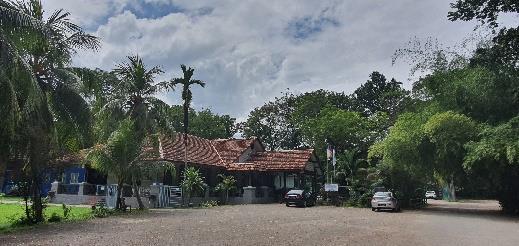
15 minute read
NEW GEN
planning and infrastructure development of Batu Kawan will be an interesting case study. Speaker shared the plan for Batu Kawan and the way towards the future. Following the proven track record in creating state-of-the-art manufacturing and technologies, Batu Kawan will have 5 objectives in its ecosystem: 1. Strong industrial base 2. Affordable housing 3. High-End Residences
4. Emerging supporting cluster in education 5. New retail & recreational facilities Other initiatives by the state of Penang are: i. Batu Kawan as an Eco-City. ii. Penang Smart City
Advertisement
The talk was moderated by Dato’ Ir. Lim Kok Khong. There were over 60 participants attended the talk.
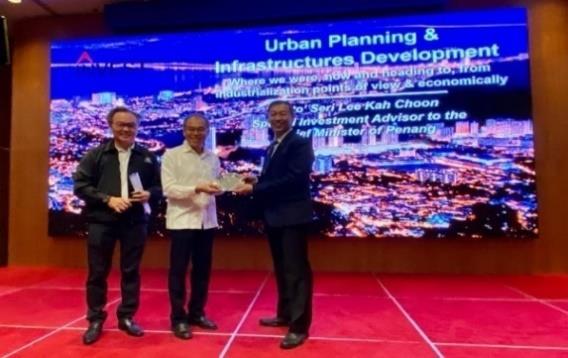
Dato’ Ir. Lim Kok Khong (left) and Ir. Bernard Lim (right) presenting appreciation certificate to Dato’ Seri Lee Kah Choon (centre) after the talk.
ROUND TABLE DISCUSSION ON IMPLEMENTATION OF RENEWABLE ENERGY (RE) AND ENERGY EFFICIENCY (EE) IN PENANG
by Ir. Khaw Yao Shun
Instead of viewing renewable energy (RE) and energy efficiency (EE) as just goals, let us first ask ourselves what is the motive for implementing RE and EE in Penang? Why is there a need for the existence of RE and EE and how do they relate to our everyday life? Coiled in the late 20th century, these two terms are often associated with efforts of reducing carbon footprints on the earth. Both RE and EE are distinctive yet correlated. RE is on the macro scale. It is about utilising energy that is clean and unlimited where it is easily replenished. The energy should be abundant and leave no carbon trace behind. However, the exploration of the energy itself must also be clean and not at the expense of nature. One of the renewable energies is solar energy which is plentiful in Malaysia. It is a good practice to install solar panels on the rooftop of buildings to harness solar energy. Malaysia is advancing with the introduction of NEM (Net Energy Metering). The concept is to pay users the amount of energy equivalent to how much they have produced using the solar panel. It also further attracts users with the introduction of incentives like Green Investment Tax Allowance (GITA), and other tax waivers. Nevertheless, it is wise to think of how much roof space has to be sacrificed in order to install a determined number of solar panels as well as how much energy can be produced on the number of solar panels installed. The capital cost must be justified with the operational earnings or else it will not be viable from a business point of view and is not sustainable in a market sense. On the other hand, EE is on a micro-scale. It is more about the habitual and mentality of the user. Essentially, it revolves around how a building utilises less energy to maintain operations at the same level, thereby leaving less carbon footprint from the energy of hydrocarbon. EE can be easily achieved via good engineering design and prudent consumption habits.
Note that a high EE building may not necessarily leave lesser carbon footprint as compared to a low EE building that derives its energy from RE. However, it is relatively easier for EE to be implemented by the general public. Therefore, EE contributes the most points to the Green Building Index (GBI).
Under the Penang 2030, all new developments with GBI Gold certified from 2020 onwards are listed under the category “Invest in the built environment to improve resilience – Implement climate change adaptation plans”. It is opined that by fulfilling the GBI requirement, RE and EE, which are requirements included in the index, would have already been implemented in Penang indirectly.
The article is representing opinion conveyed in “Perbincangan Tenaga Diperbaharui (RE) dan Kecekapan Tenaga (EE) Pulau Pinang” which was held on 25 September 2020 at KOMTAR, chaired by YB Zairil Khir Johari, Exco Kerja Raya, Utility dan Tebatan Banjir.
IEM PENANG MALAYSIA DAY CYCLING
Queensbay Mall to Karpal Singh Drive
Date
: 16th September 2020 (Wednesday) Time : 0615hrs-0800hrs No. of Participants : 15 Reported by: I
Ir. Wong Kok Nian Lim Wei Hong Group Photo near the Penang Bridge
Ir. Bernard Lim at finishing line of Ironman Langkawi 2017
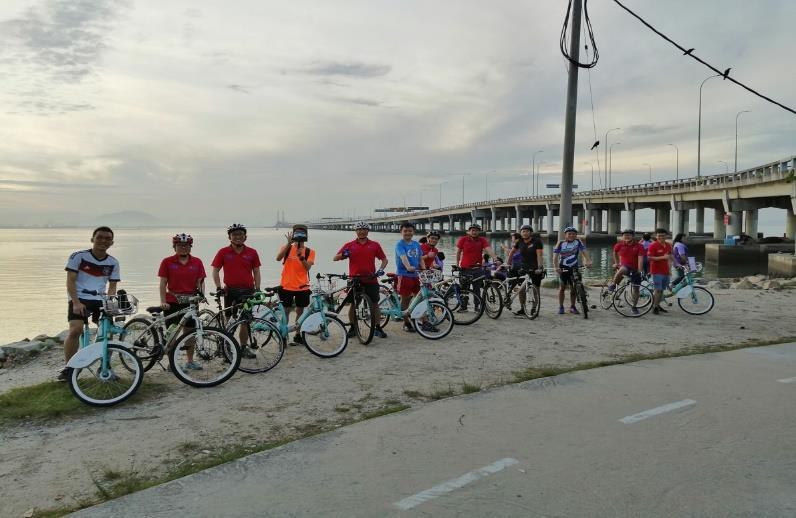
In conjunction with Malaysia Day, the first cycling event of 2020 had been organized by the Young Engineer’s Section of the Institution of Engineers, Malaysia (Penang Branch). This event was organized to celebrate Malaysia Day as well as to raise the awareness of health among engineers. The route taken is the dedicated bicycle lane connecting the east coast of Penang Island.
At approximately 0615hrs, participants gathered at Queensbay Mall Link Bike Station. They then rented bicycles from the Link Bike station before riding to Karpal Singh Drive. It took approximately 1 hour for all participants to reach the destination, which is approximately 10 km in distance. Along the way, the scenery by the sea along the bicycle lane is beautiful and all participants stopped under the Penang Bridge to take some photographs. After breakfast near Karpal Singh Drive, half of the team return to the starting point using the original route.
This event was led by IEM Penang YES Committee Mr Lim Wei Hong, and with great honour participated together with IEM Penang Executive Committee Dato’ Ir. Dr. Goh Teik Chong, Ir. Bernard Lim, Ir. Chan Wah Cheong, and other 14 IEM YES Members.
MY IRONMAN JOURNEY
by Ir. Bernard Lim
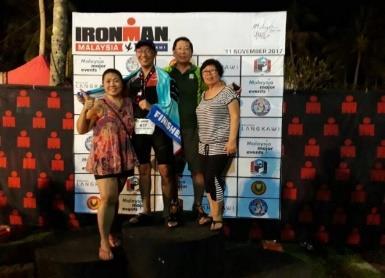
My Ironman journey started back in 2016. I had always been running marathons to keep myself healthy. I was overweight, 120kg and when I started running, I managed to reduce my weight down to 80kg. I used to cycle and swam back in my school days, but I had never thought that I will participate in such a multi-sports event like Ironman.
I was encouraged by my friend Mei Chee Seong to join a group of athletics that has been participating in multi-sports known as AM.i.3. This is really a great team of friends that pushes one to excel.
Training for an ironman event took lots of my time. I usually do averagely a total of 50KM running, 200KM bike and 3-4KM swim weekly, which took approximately 12-15hrs per week. Running is easy for me as I had already been running marathons or Ultramarathons all this while. My toughest discipline is cycling and therefore, I spend most of my weekends cycling. My first Ironman (226KM) event was on 11 Nov 2017 in Langkawi, Kedah. I trained for almost 8 months for the event and went to the actual site for training twice before the event. Unfortunately, as it was getting close to the event, I had an accident and fell from my bike on 29 Oct 2017 which was about two weeks before the Ironman Langkawi 2017. It was a bad fall while going downhill on my bike training at Sumpitan, Lenggong. I fractured my sternum from the fall but fortunately, there were no broken ribs or broken collar bone. Doctors advised me not to participate in the upcoming Ironman event. However, as I have put in so many training hours to prepare myself for the event, I decided to go ahead with the challenge, promising to stop if I deem unfit to continue. Completing the Ironman Langkawi 2017 was really one of my greatest achievement. I completed it almost to the cut off time with a time of 16 hours 18.22 mins. Subsequently after the race in 2017, I went on to participate in the following year Langkawi Ironman 2018 but this time I was better prepared, and I came in with a time of 15 hours 6.25 mins. Things that I have learned from Ironman challenges are determination, focus and never give up. Once I have put my mind on a task, I will work on it, take it one day at a Group photo with family members time. The Ironman journey has been a great experience for me; outside of my day to day live as an engineer.
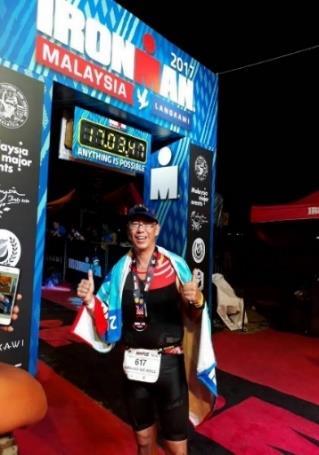
MUSIC & MATHEMATICS
by Ir. Ooi Zi Xun
According to Oxford Learner’s Dictionaries, music is defined as sounds that are arranged in a way that is pleasant or exciting to listen to. People sing music or play it on instruments. The word music comes from the Greek word (mousike), which means "(art) of the Muses". In Ancient Greece the Muses included the goddesses of music, poetry, art, and dance. Someone who makes music is known as a musician. Music is sound that is arranged by rhythm, melody, harmony and can be characterised as such:
1. Pitch – high and low notes 2. Rhythm – beat / how sound and silences are being arranged. 3. Dynamics – arrangement of soft and loud 4. Timbre – the distinctive quality of sound, i.e., gentle, warm, dark, hazy, etc.
Frequencies of Music Notes
After explaining the fundamental of music, have you ever imagined that music can be presented in mathematical equations? And did you recall studying the physics of sound and wave during high school? You will be surprised by reading the following paragraphs.
Photo 1 below shows a keyboard / piano black & white key with corresponding frequency. So, what are your guess on the relationship between music and mathematics?
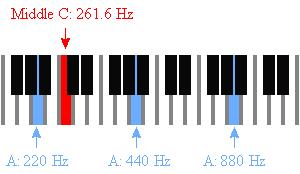
Photo 1: Keyboard / Piano black & white key and its frequencies
Yes, my fellow engineers, you are right! Music is made up of sound and thus musical frequency can be formulated as such:
Frequency, v = 440 x 2n/12, for n = -21, -19, ……, 27 The relationship between note and frequency is shown in graph 1.
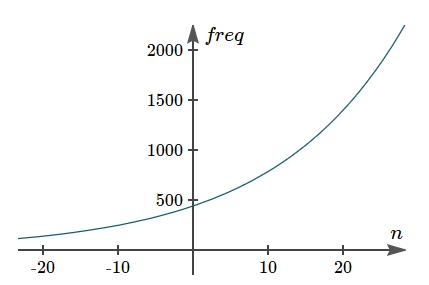
Graph 1: Note frequencies (exponential curve)
A sine wave with frequency v in Hertz, peak amplitude c and phase �� will correspond to a sine wave of the form: ��sin(2������+��) For example, in photo 2, modern concert pitch places the note A above middle C, at v = 440 Hz.
Photo 2: Modern concert pitch A
So, this would be represented by a wave of the form: ��sin(880����+��)
Examples of Relationship between Music and Mathematics
1. Notes, intervals, scales, harmony (consonance and dissonance), tuning, and temperaments are related to proportions and numerical relations, integers, and logarithms. 2. Mathematical concepts are present in melody and rhythm; musical notation includes concepts of time (length of notes, bar lines, and time signatures), rhythm (beat and the grouping of notes in tempos), pitch (clefs, staff, and frequency of the sound), and dynamics (signs of graduation of intensity), all in the circle of musical space (geometry of music). These elements are related to certain arithmetical operations (division, multiplication, addition, and logarithmic function), trigonometry, and geometry. 3. Mathematical patterns and motifs (types of symmetries) have been employed in musical compositions by a number of composers within geometrical ideas. Some examples are the motet Non vos relinquam orphanos by Byrd, fugues by J. S. Bach, and Le coulis cendre from the Catalogue d’oiseaux by
Messiaen, etc. 4. The mathematical concepts of the “Fibonacci sequence” and the “Golder Section” theory may be found in musical compositions, such as piano sonatas by Mozart.
Thus, music is connected to several different areas of mathematics, i.e., arithmetic, geometry, and trigonometry.
1. Enhanced memory: According to Laurel Trainor, who directs the Institute for Music and the Mind at
McMaster University in Ontario, Canada. Her research indicates that musical training seems to modify the brain’s auditory cortex. She suggests that playing music in concert with others requires a particularly high level of attention and memory, perhaps leading to greater effects. 2. Improved literacy: Learn to play an instrument helps children develop “neurophysiological distinction” between certain sounds. Because the mechanisms for processing sound and speech are similar, this can lead to improving literacy as well. 3. Better cognitive learning, particularly in logical reasoning, spatial reasoning, and spatial reasoning:
Playing a melody involves reconstructing a spatialtemporal pattern in which the elements are not puzzle pieces but notes of high and low pitches of long and short duration. The understanding of fractions and rations confirms the role of spatial-
temporal reasoning in a number of mathematical operations. 4. Higher IQs: According to a 2006 study published in the Journal of Educational Psychology, music lessons appear to improve children’s IQ and academic performance. The 2006 study found that for children, music lessons were positively correlated with higher school grades and higher scores on achievement tests. It also found that musical instruction was a predictor of higher IQs in young adulthood as well as higher high school grades.
Conclusion
Music has a power that’s practically immeasurable. It transcends time and language, expresses and influences our emotions, educates and entertains, and so much more. Scientists are also beginning to understand the impact music has on our brains. Essentially, the effect is massive, and it has a particularly strong influence on the brains of children. I hope that this article triggers fellow engineers’ interest & knowledge about music from the perspective of science, mathematics, and engineering.
SNailKitchen
by Ir. Tean Sze Nee
Almond Cookies Chocolate Banana Cereal Muffin


Recipe:
Ingredient A: Butter in room temperature 150g, Fine sugar 70g Ingredient B: Egg 2 nos Ingredient C: Low protein flour 150g, Coco powder 15g Instant cereal 3 tbsp, Baking soda powder 4g Ingredient D: Milk 45g, Chocolate beans 20g Ingredient E: Banana 2 nos cut into pieces
Steps:
Add Ingredient B) slowly into ingredient A) and mix well.
1. Add Ingredient C into 1 and mix well. 2. Mix ingredient D into 2 and mix well with hand mixer. 3. Add 3 into cups (70% full) 4. Add banana into the center of cups. 5. Preheat the oven 180°C and bake the cups for 25 minutes

by Gary Ng Lit Phin, IEM-USM Student Section
Despite the outbreak of Covid-19, IEM-USM Student Section has continued its activity for the student community of Universiti Sains Malaysia. The student engagement and networking session has been conducted with GAMUDA Berhad on the 2nd of December 2020, through a virtual platform. This webinar session entitled “Everyday Life of a Gamuda Engineer” has attracted participation from nearly 90 students from Universiti Sains Malaysia.
The organizing committee had invited two distinguished speakers from Gamuda Berhad. They are Mr. Keith Gabriel Gan and Mr. Foo Han Piew. Mr. Keith graduated with a Bachelor of Human Resources Management. He is a Talent Acquisition & Employer Branding Executive of Gamuda Berhad. He manages end-toend recruitment exercises including sourcing, interviewing, and hiring of fresh and senior recruits, and also establishes Gamuda’s brands with several reputable universities including Universiti Sains Malaysia. The other speaker is Mr. Foo who is also an alumnus from Universiti Sains Malaysia in Civil Engineering. He is currently an assistant manager in Gamuda Construction Training Unit (CTU). He was involved in the Electrified Double Track and Line 1 (Sg Buloh – Kajang).
During the talk, Mr. Keith i n t r o d u c e d the b a c k g r o u n d, c o r e b u s i n e s s a n d management policy of Gamuda Berhad. Gamuda Berhad mainly focuses on engineering construction, property development and infrastructure concessions which improve the living quality of our country. Mr. Keith h a s highly inspired the participants with t h e q u o t e ‘We are working as a team but not individual, so every decision we made must consider the team and the members behind us with no one left alone’. The participants have gained an insight into Gamuda Berhad.
After that, Mr. Foo introduced his working life after graduating from Universiti Sains Malaysia in story form. From the story of Mr. Foo, participants learnt that everything starts up hard and tough but do not give up when facing any challenges as these challenges are precious experience for future life. A Chinese idiom states that your hard work will be paid off and everything will become better after overcoming times of hardships. Last but not least, Mr. Foo and Mr. Keith told the participants that each of them has their special traits and personality, and the most important thing is to have a strong heart, clear mind, and good attitude in the engineering world.
Participants have gained early exposure to future working life through this engagement session. The session has benefited participants with valuable knowledge and skillsets as an engineer. Participants have also been aware of the importance of technology in the engineering field.
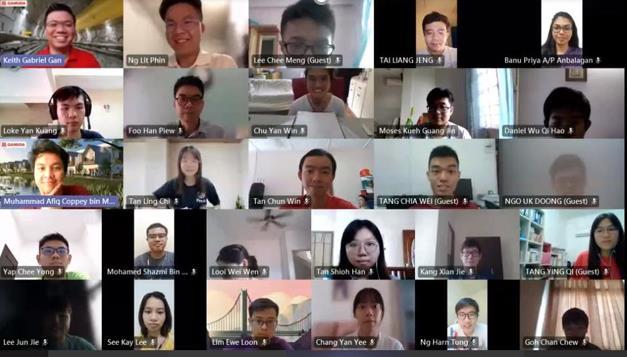
Webinar session between USM students and Gamuda
IEM PENANG BRANCH ACADEMIC AWARD
The IEM Penang Branch Executive Committee on 20 October 2020 had the monthly committee meeting and decided to approve the Institution of Higher Learning (IHL)’s request for Book Prize with certification for the approved engineering programmes with the following conditions: -
➢ The IHL must have established an IHL-IEM student section. Currently in Penang, Universiti Sains Malaysia (USM) and Universiti Teknologi MARA cawangan Pulau Pinang (UiTM) have IEM student sections. USM has 11 engineering programmes and UiTM cawangan Pulau Pinang has 4 engineering programmes. ➢ The engineering programmes must be an accredited Bachelor of Engineering Degree by Engineering Accreditation Council (EAC) of Malaysia. ➢ The Book Prize is a cash prize of RM300 for each of the best student from the above 15 Engineering Programmes, with IEM Penang Branch Certificate. ➢ The Book Prize will be awarded to only the best First Year Student of each Engineering Programme. The student will be graded based on their year one Cumulative Grade Point Average (CGPA) results. If more than 1 student received the same top CGPA results, the IHL will choose the best among them based on their extra-curricular activities. ➢ The IHL has to send the recommended list of student names with their Identity Card Number and their results to ththe Chairman of IEM Penang Branch for approval prior to 30 October 2021. ➢ The awards will be presented in one of the events organized by the IHL or IEM Student Section. The awards are likely to be presented during the fourth quarter of the year. ➢ These awards will be considered from year-to-year basis subject to application by IHL and approval by IEM Penang Branch. (For more details, please refer to IEM Penang Branch Secretariat)



